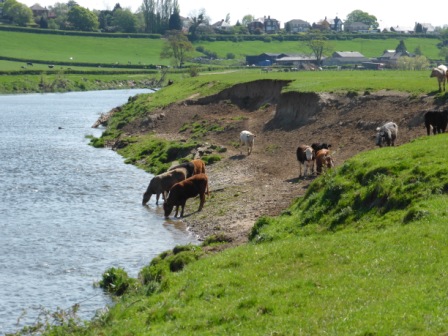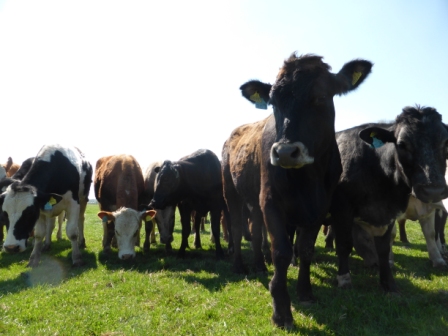The name ‘Bel’ means ‘Bright’, ‘Shining’ or ‘Mighty’ and is attested across Celtic speaking countries from northern Italy and Austria to Gaul and Britain in many variants: Bel, Belenus, Belenos, Belinos, Belinu, and Bellinus. Here in Lancashire I know him as Bel and suspect he gives his name to Belthorn and Belgrave.
‘Belisama’ means ‘Most Bright/Shining/Mighty One’ and also translates as ‘Summer Bright’. She was venerated in Gaul and Ptolemy labels the Ribble estuary in Lancashire ‘Belisama Aest’. Nick Ford suggests the name of the Ribble derives from Riga ‘Queen’ Belisama (Ri…Bel).
Within my locality, Bel and Belisama are constant presences as sun god and goddess of the Ribble’s shining waters. However, their presence feels strongest from Calan Mai/Beltane to the Summer Solstice. Etymological and historical links show their associations with Beltane.
Beltane is a Gaelic festival first attested in the Irish glossary Sanas Chormaic. Under ‘Beltane’ both texts have ‘“lucky fire”, ie. two fires which Druids used to make great incantations, and they used to bring the cattle against the diseases of each year to those fires’. In the margins under ‘Bil’: ‘from Bial ie. an idol god, from which Beltine ie. fire of Bel’. Belfires are also recorded in Scotland, Nottinghamshire, Lincolnshire and Cumbria.
In Great Singleton and Lancaster in Lancashire there was a triennial cattle fair on May Day called Beltancu. This shares similarities with the treth-Calan-Mai in Wales, where a tribute of cows was paid to King Maelgwn of Gwynedd in the 6thC. The bondsmen of Great Singleton gave four cows to their lord’s stock and Skorton and Overton paid cowgeld. I imagine it was around this time the cows from my home town of Penwortham were once moved to their summer pastures in Brindle.
Lancashire folklorists John Harland and T.T. Wilkinson claim ‘the heathen cult’ of Bel ‘lingered’ in the Fylde area. ‘From the great heaps of stones on eminences, called Cairns or Toot-hills*… and the Belenian eminences, whereon was worshipped Bel… the grand sacred fires of the Bel-Tine flamed thrice a year… on the eve of May-Day, on Midsummer Eve, and on the eve of the 1st November.’
They also record that ‘Beltains’ or ‘Teanlas’ were lit beside the Ribble on Halloween and ‘cakes as the Jews are said to have made’ are baked ‘in honour of the Queen of Heaven… Belisama.’ It seems possible similar rites took place on Beltane too.
The baking of oatcakes on Beltane is certainly recorded in other areas. At a Bel-tein in the Highlands, a large caudle was baked and shared. Nine knobs were broken off as offerings to the preservers of the flocks and herds and to the animals.
In Perthshire, the person who received a charred piece of the oat cake was seen as devoted to Baal (Bel) and made to jump through the fire three times. Similar rites are recorded in Caithness and Derbyshire. Anne Ross says this may echo earlier traditions of human sacrifice.
I’ve celebrated Bel and Belisama’s presence in the land at this time of year in various ways. A few years ago, I organised a ritual for them with UCLan Pagan Society. This involved two processions of people circling the room singing fire and water chants, then leaping over a bowl of water with a candle in it to a chant gifted me whilst walking beside the Ribble:
Bel and Belisama
join together
fire on water
sun on the river.
This was followed by readings of poems and stories, then feasting, and libations outside the building at the end. I’ve also read my poem ‘Summer Bright’ for Belisama in public.
This year, I experienced a magical moment on the hot second week of May without having made any set plans. I went for a bike ride from Penwortham toward Brockholes and stopped beside the Ribble where the sun was dancing from the sparkling water.

Downriver I noticed a group of cows had descended into the water to drink. I sat for a while, counting swallows, losing myself in the play of light on ripples, the song of the wind. When looked back, the cows were standing in a semi-circle around me: they seemed to have approached without a sound!

On the next sunny day I baked an oatcake and took it to where the cows had descended into the Ribble. As the sun broke through the clouds to shine on the river I offered it to Bel, Belisama, the keepers of cows, the cows, a nearby heron, the swallows and gulls.
*According to Harland and Wilkinson ‘the hills dedicated to the worship of the Celtic god Tot, or Teut, or Teutates’.
SOURCES
Anne Ross and Don Robins, The Life and Death of a Druid Prince, (Summit Books, 1989)
James MacKillop, Dictionary of Celtic Mythology, (OUP, 1998)
John Harland and T.T. Wilkinson, Lancashire Folklore, (Kessinger, 1867)
Ronald Cunliffe-Shawe, Men of the North, (Leyland Printing Co, 1970)
Ronald Hutton, Stations of the Sun, (OUP, 1996)
Was there meant to be a footnote on toot-hills? I’d be interested to read a post on these landscape features.
LikeLike
Oops. Sorry, must have deleted it accidentally when I added the sources. That should say ‘According to Harland and Wilkinson ‘the hills dedicated to the worship of the Celtic god Tot, or Teut, or Teutates’.’ Apologies, I don’t know any more about the Toot-hills or their possible connection with Teutates. One to investigate further…
LikeLike
A lovely story, anyway. I like the way you’re bringing lore to life, in your own life within today’s living landscape.
LikeLike
This is fascinating about the Belisama, my river is the Severn or Sabrina there is not much known about how she was worshipped but like most of the Goddesses of the rivers I suspect there were similar rites of giving offerings of food, lighting holy fires, and so forth, afterall they gave life to the land and that power needed to be respected and celebrated.
LikeLike